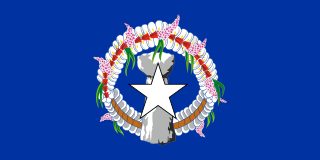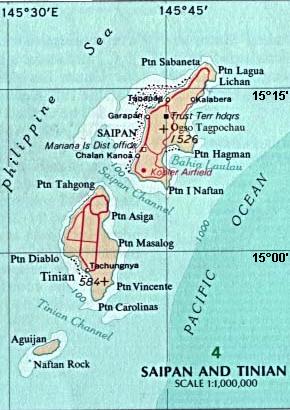Related Research Articles

The Northern Mariana Islands, officially the Commonwealth of the Northern Mariana Islands (CNMI), is an unincorporated territory and commonwealth of the United States consisting of 14 islands in the northwestern Pacific Ocean. The CNMI includes the 14 northernmost islands in the Mariana Archipelago; the southernmost island, Guam, is a separate U.S. territory. The Northern Mariana Islands were listed by the United Nations as a non-self-governing territory until 1990.

Saipan is the largest island and capital of the Northern Mariana Islands, a Territory of the United States in the western Pacific Ocean. According to 2020 estimates by the United States Census Bureau, the population of Saipan was 43,385. Its people have been United States citizens since the 1980s. Saipan is one of the main homes of the Chamorro, the indigenous people of the Mariana Islands.

Tinian is one of the three principal islands of the Commonwealth of the Northern Mariana Islands (CNMI). Together with uninhabited neighboring Aguiguan, it forms Tinian Municipality, one of the four constituent municipalities of the Northern Marianas. Tinian's largest village is San Jose. Tinian is just south of the Northern Marianas' most inhabited island, Saipan, but north of the populated Rota to the south. The island has many World War II historical sites, cattle ranches, and beaches. There was a 5-star casino that operated from 1998 to 2015; the remaining are other hotels/resorts and a golf course. The main Saipan access is a short airplane ride from the international airport or a charter boat.

Continental Micronesia, Inc. (CMI) was a Guamanian company which was a wholly owned subsidiary of Continental Airlines. It operated daily flights to Honolulu, Hawaii, as well as international services to Asia, Micronesia and Australia from its hub at Antonio B. Won Pat International Airport on Guam, a U.S. territory in the western Pacific Ocean. During its final years, the airline, a Delaware corporation, was headquartered in the old terminal building at Won Pat International Airport in Tamuning, Guam.
Evan Montvel Cohen is an American businessman living on the island of Guam. He was a founder and the first chairman of the liberal Air America Radio. Cohen has worked primarily in the broadcasting industry and in politics.

KUAM-TV is a television station in Hagåtña (Agana), Guam, serving the U.S. territory as an affiliate of NBC and CBS. Owned by Pacific Telestations, LLC, it is sister to the local public access cable channel Local 2. KUAM-TV's studios are located at 600 Harmon Loop in Dededo, and its transmitter is located east-northeast of Agat.

KTGM is a television station in Tamuning, Guam, serving the U.S. territory as an affiliate of ABC. It is owned by Sorensen Media Group and operated by Lilly Broadcasting alongside low-power Fox affiliate KEQI-LD. The two stations share studios on 111 Chalan Santo Papa in Hagåtña (Agana); KTGM's transmitter is located in the heights of Barigåda (Barrigada).

KTKB-LD is a low-power television station licensed to Tamuning, Guam, serving the U.S. territory as an affiliate of The CW Plus. Owned by Chicago-based KM Communications, the station is operated by Marianas Media under a local marketing agreement (LMA). It is carried island-wide on cable channel 4 on MCV Broadband and GTA's GUdTV system.
KEQI-LD is a low-power television station in Dededo, Guam, serving the U.S. territory as an affiliate of the Fox network. It is owned by Sorensen Media Group and operated by Lilly Broadcasting alongside ABC affiliate KTGM. The two stations share studios on 111 Chalan Santo Papa in Hagåtña (Agana); KEQI-LD's transmitter is located in the heights of Barigåda (Barrigada).

Alamagan is an island in the Northern Mariana Islands in the Pacific Ocean, 30 kilometres (16 nmi) north of Guguan, 250 kilometres (135 nmi) north of Saipan, and 60 kilometres (32 nmi) south of Pagan. It is currently undergoing resettlement since 2018, with a few people living there. The project was coordinated by the Northern Islands Mayor's office and the people there have radio contact with the mainland.
KSTO, branded as K-Stereo 95.5, is an adult contemporary radio station serving the island of Guam, licensed to Hagåtña. KSTO is owned by Inter-Island Communications.
KICH is a radio station broadcasting from the village of Dededo, in the United States territory of Guam.
The Habele Outer Island Education Fund is a South Carolina–based charitable organization serving K-12 aged students in Micronesia. Habele's initial geographic focus was the so-called "Outer Islands" of Yap State as well as lagoon and outer islands in neighboring Chuuk State in the Federated States of Micronesia. It now serves students of all backgrounds throughout the Freely Associated States.
Rex Sorensen was the chairman and CEO of Sorensen Media Group. He was a founding board member of Air America Radio.
The Marianas Practical Shooting Association (MPSA) is a Guamanian association for practical shooting.
NBC 10 may refer to one of the following television stations in the United States:

The 2022 Northern Mariana gubernatorial election took place on November 8, 2022, to elect the governor of the Northern Mariana Islands and the lieutenant governor of the Northern Mariana Islands to a four-year term in office. Because no candidate received 50% of the vote in the general election, the two highest-placing candidates advanced to a runoff election on November 25, 2022.
Claire Lynn Raulerson was an American plant biologist who worked in Guam and specialised in the study of Micronesian plants, especially those of Guam and the other Mariana Islands. She held her position in biology at the University of Guam for over forty years.
KPON-TV is a television station broadcasting from Kolonia, capital of Pohnpei State, in the Federated States of Micronesia. The station is a commercial operation.
References
- ↑ "History Cards for WSZE-TV". Federal Communications Commission. (Guide to reading History Cards). Card record begins with a 1978 license to cover application. One of several history card sets unbound to a facility ID; the FCC notes "final status uncertain".
- ↑ "Micronesia Titles Changed". Hawaii Tribune-Herald. Associated Press. October 10, 1969. p. 2. Retrieved September 9, 2020.
- 1 2 3 "Saipan's Window On The World". Pacific Daily News. November 2, 1970. p. 4. Retrieved September 9, 2020.
- 1 2 Killgore, Scott (November 16, 1970). "Frontier of TV" (PDF). Broadcasting. p. 16. Retrieved September 9, 2020.
- ↑ "WSZE Asks Studio Move". Pacific Daily News. October 12, 1973. p. 7. Retrieved September 9, 2020.
- ↑ King, Joan (December 18, 1974). "Radio Power Halted To Check TV Plan". Pacific Daily News. p. 3. Retrieved September 9, 2020.
- ↑ King, Joan (February 5, 1975). "2 New Radio Stations For Saipan By April?". Pacific Daily News. p. 7. Retrieved September 9, 2020.
- ↑ "Saipan Station Erects New Antenna". Micronesia News Service. November 6, 1975. p. 20. Retrieved September 9, 2020.
- ↑ "Commercial Station Begins On Saipan". Pacific Daily News. Micronesia News Service. June 21, 1976. p. 7. Retrieved September 9, 2020.
- ↑ "WSZE TV Program Schedule". Marianas Variety News & Views. March 31, 1977. p. 19.
- ↑ Hillinger, Charles (January 9, 1978). "Islands Deep in Pacific Become a Part of U.S." Los Angeles Times. p. 18. Retrieved September 9, 2020.
- ↑ "WSZE Local Manager Resigns". Marianas Variety News & Views. October 16, 1979. p. 1.
- ↑ "COMSAT Links Saipan To World". Marianas Variety News & Views. November 7, 1980. p. 8.
- ↑ Rosario, Frank (January 15, 1983). "Saipan radio station evicted". Pacific Daily News. Retrieved September 9, 2020.
- ↑ "Lockout At Radio Station". Marianas Variety News & Views. January 23, 1981. p. 3.